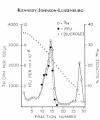Isolation and morphology of the internal component of human coronavirus, strain 229E
- PMID: 1235860
- PMCID: PMC7179545
- DOI: 10.1159/000149474
Isolation and morphology of the internal component of human coronavirus, strain 229E
Abstract
Biochemical studies on human coronavirus, strain 229E, indicate that the RNA is present in the virion in association with protein as a ribonucleoprotein (RNP) complex. Morphological studies have revealed that this nucleocapsid is probably a continuous helical RNP.
Figures





References
-
- Apostolov K., Flewett T.H. Internal structure of influenza virus. Virology. 1965;26:506–508. - PubMed
-
- Horse R.W., Waterson A.P. A helical structure in mumps, Newcastle disease and Sendai viruses. J. molec. Biol. 1960;2:75–77.
-
- Howatson A.F., Whitmore G.F. The development and structure of vesicular stomatitis virus. Virology. 1962;16:466–478. - PubMed
-
- Simpson R.W., Hauser R.E. Structural components of vesicular stomatitis virus. Virology. 1966;29:654–667. - PubMed
-
- Nowinski R.C., Lloyd J.O., Sarkar N.H., Moore D.H. Common properties of the oncogenic RNA viruses (oncornaviruses) Virology. 1970;42:1152–1157. - PubMed
MeSH terms
Substances
LinkOut - more resources
Full Text Sources

